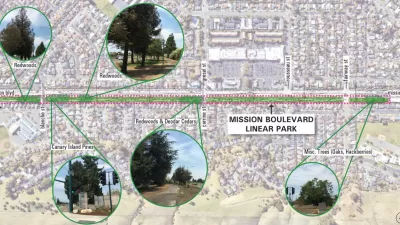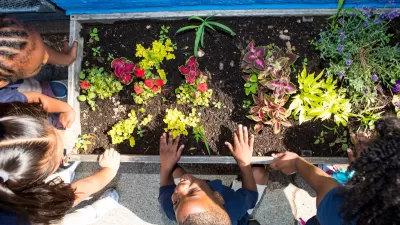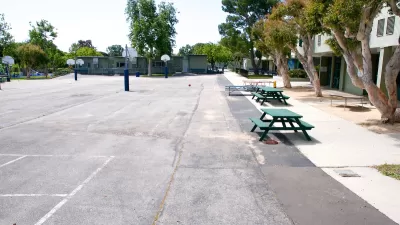New research suggests that switching from asphalt to green, park-like schoolyards brings economic benefits in addition to public health improvements.

“A new study from Trust for Public Land effectively dispels a common misconception among school administrators about the price tag of transforming asphalt-covered and treeless schoolyards into green schoolyards,” according to a press release from TPL. “The study compared the typical cost of building and maintaining a traditional ‘gray’ or asphalt-covered schoolyard in California to a ‘green’ schoolyard (replacing asphalt with more natural green space and infrastructure) over a 20-year period. While gray schoolyards had a moderately lower initial renovation cost ($2.3 million compared to $2.6 million for green schoolyards), they yielded no benefits over time, with schools continuing to sink money into resealing asphalt.” By contrast, green schoolyards bring close to $600,000 in net benefits. These include higher student attendance and staff retention, better academic performance, and savings on energy costs.
“The findings make a strong case for schools to stop wasting resources in maintaining asphalt and blacktop – surfaces that create uncomfortable and dangerously hot environments during recess on triple-digit temperature days in Los Angeles – and instead invest them in green schoolyards, which create safer, healthier learning environments for students.”
Green schoolyards can also double as community parks outside of school hours, providing critical green space in park-poor neighborhoods. “Trust for Public Land’s pilot program with the Oakland Unified School District is improving park equity in the area by bringing green schoolyards to five campuses.” In Southern California, Los Angeles Unified School District’s superintendent Alberto Carvalho has pledged to issue a plan for greening the city’s schoolyards.
FULL STORY: Cost-Benefit Analysis: Green Schoolyards Brings Major Benefits, Cost Savings

Alabama: Trump Terminates Settlements for Black Communities Harmed By Raw Sewage
Trump deemed the landmark civil rights agreement “illegal DEI and environmental justice policy.”

Planetizen Federal Action Tracker
A weekly monitor of how Trump’s orders and actions are impacting planners and planning in America.

The 120 Year Old Tiny Home Villages That Sheltered San Francisco’s Earthquake Refugees
More than a century ago, San Francisco mobilized to house thousands of residents displaced by the 1906 earthquake. Could their strategy offer a model for the present?

In Both Crashes and Crime, Public Transportation is Far Safer than Driving
Contrary to popular assumptions, public transportation has far lower crash and crime rates than automobile travel. For safer communities, improve and encourage transit travel.

Report: Zoning Reforms Should Complement Nashville’s Ambitious Transit Plan
Without reform, restrictive zoning codes will limit the impact of the city’s planned transit expansion and could exclude some of the residents who depend on transit the most.

Judge Orders Release of Frozen IRA, IIJA Funding
The decision is a victory for environmental groups who charged that freezing funds for critical infrastructure and disaster response programs caused “real and irreparable harm” to communities.
Urban Design for Planners 1: Software Tools
This six-course series explores essential urban design concepts using open source software and equips planners with the tools they need to participate fully in the urban design process.
Planning for Universal Design
Learn the tools for implementing Universal Design in planning regulations.
Clanton & Associates, Inc.
Jessamine County Fiscal Court
Institute for Housing and Urban Development Studies (IHS)
City of Grandview
Harvard GSD Executive Education
Toledo-Lucas County Plan Commissions
Salt Lake City
NYU Wagner Graduate School of Public Service





























